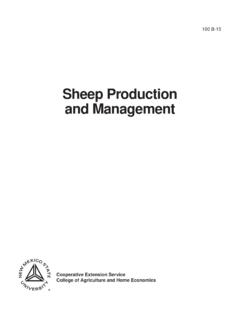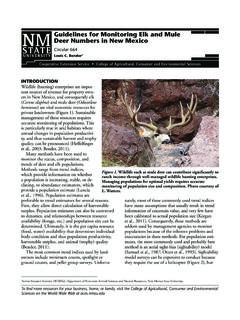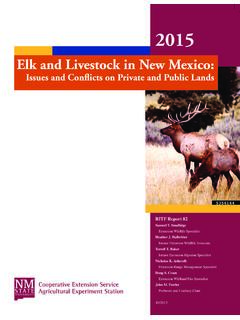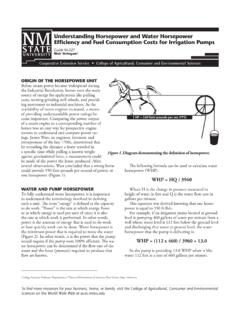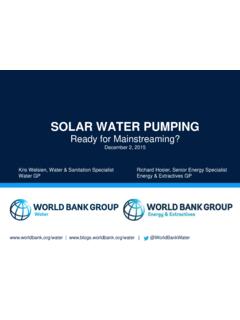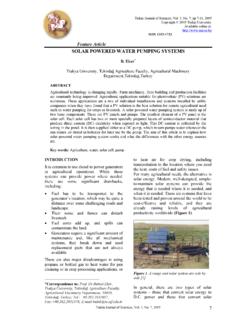Transcription of Designing Solar Water Pumping Systems for Livestock
1 To find more resources for your business, home, or family, visit the College of Agricultural, Consumer and Environmental Sciences on the World Wide Web at many parts of the world, including New Mexico (NM), Water and energy availability are growing con-cerns. In areas where connection to an electric utility is not available, the primary technologies for Water ac-cess surface sources or Pumping have remained fairly constant for decades. As demands for higher quantities and quality of Water , lower costs, improved reliability, and environmental concerns have increased, many live-stock and agricultural producers are investigating an al-ternative technology for remote Water Pumping : direct-coupled Solar photovoltaic (PV) powered the process to design and implement such a sys-tem may be a challenging task, New Mexico State Uni-versity s Engineering NM program initiated a project to provide the Cooperative Extension Service (CES) with a demonstration module, an interactive design spread-sheet, and literature related to Solar Water Pumping to better inform NM Water users about the benefits and methodology of implementing this technology.
2 Avail-able through NMSU multimedia and the CES statewide Extension agent network, these tools serve to educate interested constituencies (primarily farmers and ranch-ers) in using Solar energy to pump publication provides a general discussion of how to design a photovoltaic-powered Solar Water Pumping system for Livestock . A companion publication, Circular 671, Designing Solar Water Pumping Systems for Livestock : User Manual ( ), provides step-by-step instructions for us-ing a Microsoft Excel spreadsheet to perform necessary calculations for Designing a Solar Pumping Water SOURCES AND LIVESTOCKL ivestock, crops, and people often depend upon surface sources of Water (streams, ponds, catch tanks, etc.) or wells accessing underground aquifers2.
3 Because of a vari-ety of benefits, and increased regulations in some states, it is often desirable to move Water from a surface source to a different location, elevation, or drinker, or to pump Water from a remotely located surface sources, a well-vegetated riparian zone establishes a buffer that filters and purifies Water as it moves across the zone, reducing sediment loads, sup-porting soil stability, improving Water quality, and en-hancing wildlife habitat. Excessive Livestock pressure on surface sources often causes nutrient loading, streamside vegetation damage, erosion, pollution, and decreased animal growth and health. One approach is to remove or limit access to these areas; however, often this is the only viable Water source for producers.
4 Fortunately, research shows that in many cases Pumping Water to a different location, combined with a managed rotational grazing plan3, optimizes animal performance, pasture use, Water quality, and wildlife in these zones (Buscher-mohle and Burns, ; Morris and Lynne, 2002). While cows may wade out to obtain better Water , calves tend to only drink from the shore. By wading into surface sources, cattle pollute the Water with their urine and feces and may disturb the Water with their wading action. Eventually cattle may refuse to drink, and they will have to be moved even though local for-age is still require higher-quality Water and will not fight cows or mud to obtain it. Increases of 50 pounds/head in weaning weight have been reported when Water in sufficient quantity and quality is provided.
5 Studies have shown that, when given a choice, cattle drank from a Water trough 92% of the time rather than from a nearby stream (Bartlett, ). Research also shows that yearling steer performance increased 23% when supplied with an alternate Water source rather than dugouts (earthen dams or reservoirs). In addition to increased Livestock and resource performance, by routing the Livestock away from riparian zones, very large reductions (50 90%) in 1 Professor Department of Engineering Technology and Surveying Engineering, New Mexico State An excellent source on windmills: It has been shown that Livestock will only travel a limited distance to Water sources with typical Water source spacing of one source per 250 ha to harvest grasslands, otherwise there is strong potential for overgrazing close to Water supplies.
6 Designing Solar Water Pumping Systems for Livestock Circular 670 Thomas Jenkins1 Cooperative Extension Service Engineering New Mexico Resource NetworkCollege of Agricultural, Consumer and Environmental Sciences College of EngineeringCircular 670 Page 2streptococci and coliform fecal organisms, waterborne diseases (foot rot, red nose, TB, mastitis, etc.), nitro-gen, phosphorous, suspended solids, and surrounding erosion are realized. By Pumping Water to drinkers, ranchers can better utilize pastures, get superior animal growth and health, and provide higher-quality Water (Pfost et al., 2007; Surber et al., ). Water Pumping BASICSC osts, reliability, and environmental concerns often influence a producer s choice of surface Water pump-ing system .
7 When producers do not have economical access to grid electric power4, they generally look to op-tions such as ram, sling, diesel, wind (Figure 1), or Solar powered pumps. When these choices are compared, Solar pump Systems are often the best choice due to the operational conditions inherent to New Mexico, which allows them to function effectively and economically (Foster et al., 2010). Solar Pumping Systems for surface sources or wells can be portable, which is appealing because more and more producers want Systems that can move among various locations. Some users are even powering broken windmill pump jacks with portable photovoltaic (PV) Pumping Water from underground aquifers via wells, access to existing AC electric connections (closer than one-half kilometer or mi) is again the best op-tion.
8 In remote locations, though, PV Water Pumping Systems represent a very attractive, long-term, cost-effec-tive alternative to hauling Water , diesel pumps, and even traditional windmills for drinking Water and many ir-rigation applications (drip/trickle, hose/basin, and some channel irrigation although typically not for very high flow rates such as might be used in flood irrigation). The abundant and varied benefits of PV Systems make them attractive in many Solar Pumping system involves calculations and concepts that may make it difficult to determine a design if one is unfamiliar with the technology and ter-minologies. With this in mind, NMSU developed the following tools to aid and educate a potential user:1. Two portable demonstration devices that illustrate the concepts and major system components for a Solar Pumping system .
9 Each module is portable and therefore available for displays and Literature and educational multimedia materials related to PV Water Pumping Systems ( ), Figure 1. Windmills are still a common source of power for off-the-grid Water Pumping comparisons between three main remote Water Pumping technologies (Table 1) used in New Mexico today, contrasting two different ways to mount PV modules (fixed-angle mounting vs. single-axis tracking Systems ), and a simple cost analysis for each of the three technologies and mounting Systems (Foster et al., 2010).3. A Microsoft Excel spreadsheet to provide an easy and visual educational tool to present concepts behind PV technology and system design methodology (available to download at ). This tool allows the user to fol-low the basic step-by-step design process, and offers sample components and simple economic analysis for 4 It can cost $10,000 to $30.
10 000 per mile to install electrical power line through rugged 670 Page 3 Technology Advantages Disadvantages Solar Renewable/sustainable No fuel costs Can be portable and remote Very low operation/maintenance costs Federal and state tax incentives Acceptable capital costs and low recurring costs Reliable warranty of 20+ years for panels Relatively easy to install system is modular and may be modified to fit needs Wind Renewable/sustainable No fuel costs Federal and state tax incentives Remote applications Proven technology with pool of expertise and experience Lower initial costs Fossil fuels (diesel) Higher flow rate Often no need for storage Proven technology with large pool of expertise Easy to install Variable Water delivery depending on sun intensity Low flow rates Supplemental storage needed Extended time to meet required storage Higher initial costs (although costs are trending lower)

